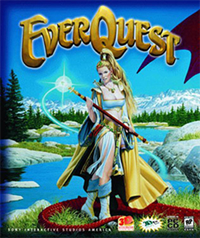The most recent headline to this effect is Everquest 2 research at U of Minnesota. Jaideep Srivastava, et al are using Everquest chat logs for social network analysis, similar to the way community interactions among flesh-and-blood people.

Though networking sites like Myspace represent a different breed of social network, they have also been at the center of countless studies. Twitter is starting to come into its own, as well.
Pictured below, Java, et al used clusters of Twitter users as a model of interactions between communities. (As a coincidental example of online networking, I realized that I am acquainted with a person at one of this study’s nodes through another networking site, Ravelry.)

When I interviewed Helen Fisher earlier this month, I asked her a question about her four profiles that she couldn’t immediately answer. “But I could just call chemistry.com and have that information in about an hour.” In fact, her quiz through Chemistry.com and WhyhimWhyher.com have given her access to an unprecedented sample size of 7 million respondents. Quizzes hold a certain irresistible draw for many people; I myself have squandered a lot of time on Quizilla amassing completely useless self-knowledge, such as “Which South Park Character Are You”. My lab friends have started taking Helen Fisher’s quiz just for the fun of comparing answers (though I'm sure nobody objects to furthering science in the bargain).
Of course, the boon of easy access to vast data comes with a price. Respondents to online quizzes and players of online games are self-selected, and this may introduce unforeseen trends in the data. Additionally, as Cole and Griffiths note, anonymity changes social interactions. Just as that profane and seemingly illiterate 13-year-old punk on Halo does indeed kiss his mother with that mouth, we tend to act differently behind the mask of an online persona. This is especially true in interactions between people who have no intention of meeting in the flesh, which is often true in online gaming societies. However, questions such as these exist to some degree in any social study. With careful controls, the value to be gained from internet data outweighs the caveats.
Though the University of Minnesota Everquest 2 study is being touted as a harbinger of a new direction for information gathering, I’d cite an example closer to home. Last year I mentored a group of students at the Sacramento Heath Professions High School through the completion of a project researching and reacting to diabetes perception in the community. The very first thing their teachers required them to learn? How to gather data using SurveyMonkey.
Srivastava, J., Pathak, N., Mane, S., and Ahmad, M. A. Data Mining for Social Network Analysis. IEEE International Conference on Data Mining (ICDM 2006), (Hong Kong, December 18--22, 2006).
Helena Cole, Mark D. Griffiths. Social Interactions in Massively Multiplayer Online Role-Playing Gamers. CyberPsychology&Behavior. August 1, 2007, 10(4): 575-583. doi:10.1089/cpb.2007.9988.
Akshay Java, Xiaodan Song, Tim Finin, Belle Tseng. Why We Twitter: Understanding Microblogging Usage And Communities. Proceedings of the 9th WebKDD and 1st SNA-KDD 2007 workshop on Web mining and social network analysis, San Jose, California. Pages 56-65.
Helen Fisher, Interview. February 10, 2009.
And just for fun, A Timeline Of The Fantasy MMORPG.




Comments